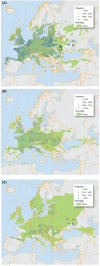Pest categorisation of non-EU Scolytinae on non-coniferous hosts
- PMID: 39286543
- PMCID: PMC11403304
- DOI: 10.2903/j.efsa.2024.8889
Pest categorisation of non-EU Scolytinae on non-coniferous hosts
Abstract
The EFSA Panel on Plant Health performed a group pest categorisation for the EU territory of non-EU Scolytinae (Coleoptera: Curculionidae) on non-coniferous hosts, which total 6495 known species. Most species attack apparently healthy, weakened or dead trees, either feeding on the phloem ('bark beetles' subgroup) or on fungi inoculated into the sapwood ('ambrosia beetles' subgroup). Smaller subgroups feed and reproduce in seeds and fruits, or in herbaceous plants. Some species are polygynous, the males initiate a gallery or a chamber on or in a new host and attract females. Others are monogamous, and the females initiate the new galleries. Many species respond to primary volatile attractants emitted by the hosts, and some produce aggregation pheromones that attract conspecifics of both sexes. The species attacking living hosts are often associated with fungi that contribute to weakening the host defences and provide nutrients to the insects. Some are inbreeding; the males in the offspring mate with their sisters and rarely leave their natal tree. The larvae of all species develop and pupate within their hosts. Based on catalogues and other published data, a database was constructed providing information on hosts, feeding and reproductive habits, geographic distribution and the Köppen-Geiger climate types in countries where species occur. The Scolytinae were screened to exclude species in the following categories: (i) 708 species attacking conifers; (ii) 127 species present in at least four EU Member States and (iii) 440 species occurring in areas with climatic conditions not occurring in the EU. Among the remaining 5220 species, 88 species known for their mobility, occupying at least two landmasses separated by geographical barriers and some of which had impact levels documented in literature, were extracted. They were grouped into four subcategories: (i) 12 species with high impact on plant health; (ii) 16 species with low or doubtful impact; (iii) 48 species with no impact; (iv) 12 species with no impact and which had never been recorded as 'introduced' in the consulted catalogues but occurring on at least two landmasses. All 88 species could enter the EU with wood or wood products, or with plants for planting, and could establish because host plants are available, and climate is suitable in parts of the EU. Control measures to inhibit introduction are available. There is considerable uncertainty regarding the potential impact of many species. Methods for the reliable identification of many species are lacking. For some species of non-EU Scolytinae on non-coniferous hosts, all criteria assessed by EFSA for consideration as potential quarantine pest are met. Nevertheless, the Panel was not able to develop a method to discriminate confidently between species that clearly meet the criteria for potential quarantine pest status and those that do not.
Keywords: ambrosia beetles; bark beetles; broadleaf; pest risk; plant health; plant pest; quarantine.
© 2024 European Food Safety Authority. EFSA Journal published by Wiley‐VCH GmbH on behalf of European Food Safety Authority.
Conflict of interest statement
If you wish to access the declaration of interests of any expert contributing to an EFSA scientific assessment, please contact interestmanagement@efsa.europa.eu.
Figures








Similar articles
-
Pest categorisation of non-EU Scolytinae of coniferous hosts.EFSA J. 2020 Jan 10;18(1):e05934. doi: 10.2903/j.efsa.2020.5934. eCollection 2020 Jan. EFSA J. 2020. PMID: 32626488 Free PMC article.
-
Pest categorisation of Ips typographus.EFSA J. 2017 Jul 6;15(7):e04881. doi: 10.2903/j.efsa.2017.4881. eCollection 2017 Jul. EFSA J. 2017. PMID: 32625546 Free PMC article.
-
List of non-EU Scolytinae of coniferous hosts.EFSA J. 2020 Jan 10;18(1):e05933. doi: 10.2903/j.efsa.2020.5933. eCollection 2020 Jan. EFSA J. 2020. PMID: 32626487 Free PMC article.
-
Ecology of Ahasverus advena in Stored Products and Other Habitats.Insects. 2025 Mar 18;16(3):313. doi: 10.3390/insects16030313. Insects. 2025. PMID: 40266819 Free PMC article. Review.
-
Neem: A Tree For Solving Global Problems.Washington (DC): National Academies Press (US); 1992. Washington (DC): National Academies Press (US); 1992. PMID: 25121266 Free Books & Documents. Review.
Cited by
-
The first host plant dataset of Curculionidae Scolytinae of the world: Hylastini LeConte, Hylurgini Gistel, Ipini Bedel, Phloeosinini Nusslin, Polygraphini Chapuis.Sci Data. 2025 May 6;12(1):751. doi: 10.1038/s41597-025-05106-5. Sci Data. 2025. PMID: 40328778 Free PMC article.
References
-
- Allison, J. D. , & Redak, R. A. (2017). The impact of trap type and design features on survey and detection of bark and woodboring beetles and their associates: A review and meta‐analysis. Annual Review of Entomology, 62, 127–146. - PubMed
-
- Alonso‐Zarazaga, M. A. , Barrios, H. , Borovec, R. , Bouchard, P. , Caldara, R. , Colonnelli, E. , … Yunakov, N. N. (2017). Cooperative catalogue of palaearctic Coleoptera Curculionoidea. Monografías Electrónicas SEA, 8(1), 729.
-
- Alonso‐Zarazaga, M. A. , Barrios, H. , Borovec, R. , Bouchard, P. , Caldara, R. , Colonnelli, E. , … Yunakov, N. N. (2023). Cooperative catalogue of palaearctic Coleoptera Curculionoidea. Monografías Electrónicas SEA, 14, 780.
-
- Anses . (2017). Anses opinion on a request for an express risk assessment (ERA) on Xylosandrus compactus (Eichhoff) identified in metropolitan France. Anses, Maisons‐Alfort, 68. https://www.anses.fr/fr/system/files/SANTVEG2016SA0170Ra.pdf
-
- Atkinson, T. H. (2023). Bark and Ambrosia Beetles of the Americas. https://www.barkbeetles.info/americas_index.php
LinkOut - more resources
Full Text Sources
Miscellaneous
